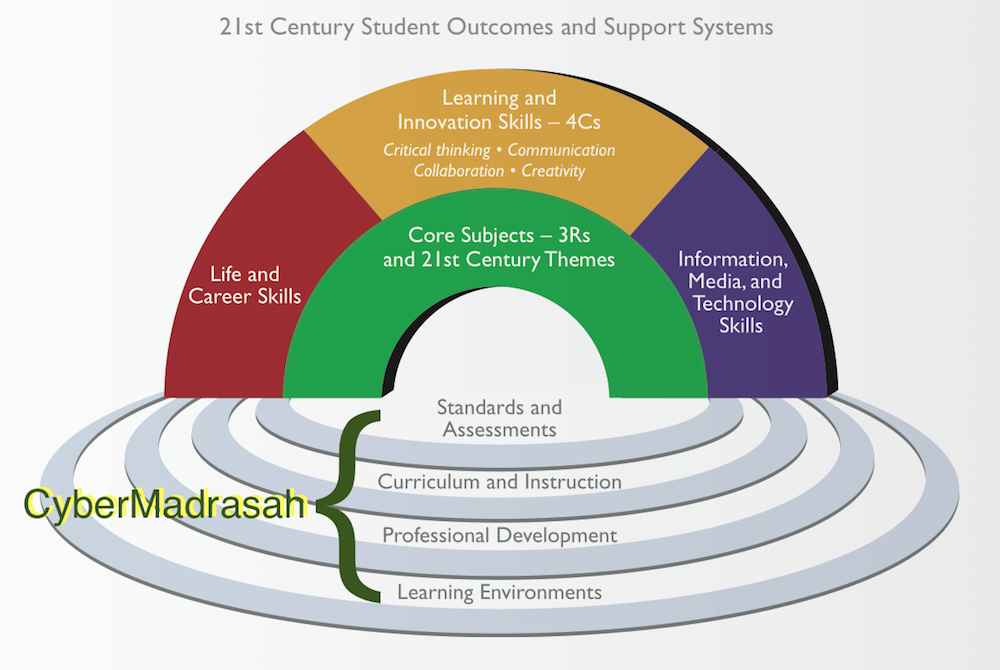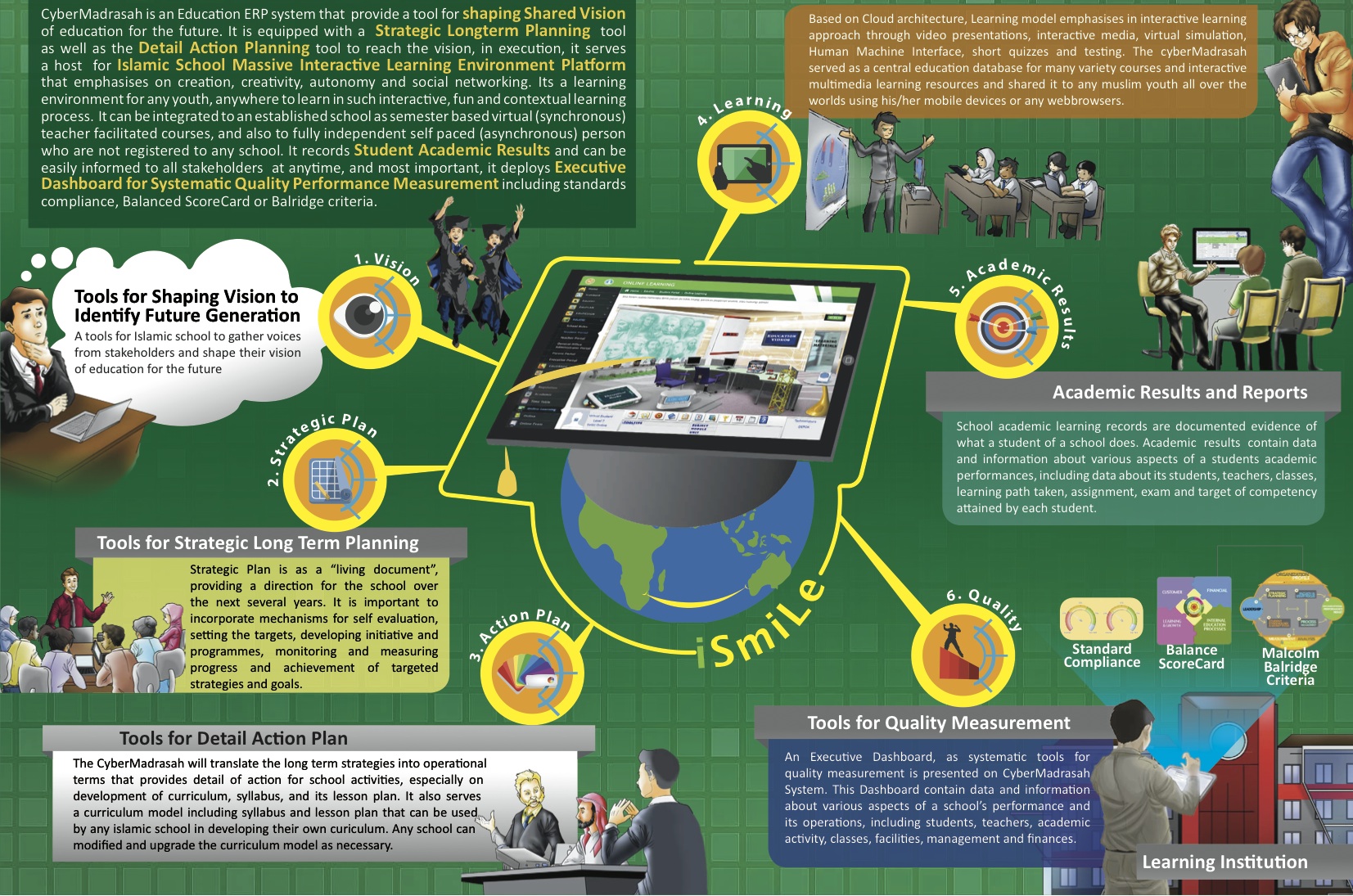CyberMadrasah : 21st Century Learning Institution
In our daily life, we operate in an almost in digital world, we discuss our work progress online, we socialize online, we follow news, we buy or sell thing online, we watch favorite films online, we file our pictures online, we bank online, and we play games and do most of our interests online. Dennis Stevenson, UK Prime Minister's Adviser on ICT and Education stated that "The modern world requires new skills. Understanding ICT and, more importantly, being able to apply it to the problems we face is one of the most important. Increasingly ICT will be vital for our individual prospects and for our economy's future." The use of digital devices by the students and teachers in their daily life, will affect learning settings and tools in educational processes,. It evidently leads to radical changes both in the role of teachers and learners and to the emergence of new teaching and learning environments and methodologies. To learn digital or computer technology is becoming a norm for any kind, the biggest Computer Science Education Week namely “Hour of Code” was launched as an annual grassroots campaign dedicated to highlighting the importance of computer science education for K-12 students. 5 million students across 33,000 classrooms in 167 countries are signed up to take part in the Hour of Code, which offers self-guided material to be used on tablets, smartphones, and computers
To response with the ever changing technology, the learning institution must be able to reengineer its education philosophy and adapt to the current and future changes to give the right response. In line with that, two areas need to be defined before we could start: setting the right targets and setting the strategic plans to achieve them.
Setting The Target of Education : Shared Vision of Future Graduate Profile
To response with the ever changing technology, the learning institution must be able to reengineer its education philosophy and adapt to the current and future changes to give the right response. In line with that, two areas need to be defined before we could start: setting the right targets and setting the strategic plans to achieve them.
Vision building is a challenging exercise as it aims to construct future scenarios and link the present with the future. By predicting the image of the future schools will able to see what kind of graduate profile would be fit for the future. Strategic planning, roadmaps and decision processes should be drawn to achieve end with objectives.
It is important for education visionaries to be able to bring together what education stakeholders want and build a shared vision and mission of a certain education institution. The graduate profile is shaped by considering the voices of education stakeholders on what attributes make good quality education outcomes. The followings should be embedded in the profile: shared local vision for education and metaphysical, cognitive, and educational tenets, and the fulfillment of a number of social, cultural, economic and higher education requirements.

Systematic Strategic Plan To Achieve The Target
It is a difficult task to implement systematic and proper strategic planning as a tool to answer future vision. Even more so is envisaging the vision, an exercise that cannot be done by simply restructuring present realities let alone by sheer dreaming. All education aspects and contemporary realities must merge into a strategic plan and be transformed into action plan, which in turn would organize, direct and control the process to attain the targets.
Strategic planning is the basis on which decisions are made on allocating resources to pursue the targets. Many organizations view strategic planning as a process for determining where an organization is going over the next year or—more typically—3 to 5 years (long term), although some extend their vision to 20 years.
A school Strategic Plan must contain aspects about the standards and assessment, curriculum and instructions, professional development as well learning environment. It is a blue print of education to be used as a guideline in school development, a basis for monitoring and evaluation purposes in terms of the execution of school plan. It also serves as a reference to identify the need for human resource as well as other resource to develop the school.

21st Century Graduate Profile and Its Support System
Recent initiative on defining the 21st Century Graduate profile was carried out by a coalition of business community, education leaders, and policymakers in USA. The outcome is a Framework that presents a holistic view of 21st century teaching and learning that combines a discrete focus on 21st century student outcomes (a blending of specific skills, content knowledge, expertise and literacies) with innovative support systems to help students master the multi-dimensional abilities required of them in the 21st century and beyond.
The key elements of 21st century learning are represented in the graphic and descriptions below. The graphic represents both 21st Century Graduate profile (as represented by the arches of the rainbow) and 21st century learning support systems (as represented by the pools at the bottom). 21st Century powerful learning nature demands well-prepared Learning Institution as well as teachers who draw on advances in cognitive science and are strategically organized in teams, in and out of cyberspace. This is the role of CyberMAdrassah. to blend standards and assessment, curriculum and instruction, professional development of academic staff and nurture a learning environment into one institution that support the making of 21st Century Graduate profile.

CyberMadrasah
The term Cyber comes from "κυβερνητικός (kybernetikos) a Greek sailor who was in charge of directing the ship course. Cybernetic denotes control of speech and functional processes, the term cybermadrassah is then proposed as an electronic tool in steering and directing the course of Madrassah/Learning Institution to produce a graduate profile capable of embracing 21st century challenges.
CyberMadrasah is a Cloud based School Management (ERP) application that enables schools to prepare for the 21st century learning outcome and demand to ensure student mastery of 21st century skills. It aligns the standards, assessments, curriculum, instruction, professional development and learning environments to produce the 21st century graduate profile. It seamlessly and strategically connects its vision, strategic planning, and plot the strategic map to achieve the vision.
It translates the strategic map into a yearly action plan with its corresponding KPIs including curriculum development plan, Human Resources Plan, and so on. It then executes the academic plan using Massive Online Open Course, MOOC based learning that can be used by large number of students in class or outside the classroom. Teachers plan and execution as well as student activities and competency attainment will all be recorded in the main cloud database to be used in further analysis for the betterment and quality improvement of school. The strategy map and target KPI translate the schools strategy into terms that everyone in the organization can understand and act upon.
School teams own the responsibility for ensuring the KPIs and map are refreshed on an annual basis and for updating the measures and targets. Finally the performance dash board is presented as a strategic tool for reporting school performance. That would allow schools to show the school Board and public whether the school activities are in line with the district or National vision and goals.
CyberMadrassah systematically merges all activities of a school in one seamless management process, from front to back. Besides detailed administrative work the system also supports academic quality improvement. CyberMadrassah deploys its quality management to achieve quality education by connecting each dot of the school activities from planning, devising executing to measuring results.
 CyberMadrassah is a new kind of Massive Open Online Course (MOOC) for Islamic schools/Madrassa that does not only serve as an Interactive MOOCs platform It is enhanced by an online strategic tool to streamline and manage the school activities. Three main activities are covered: planning, execution and evaluation.
CyberMadrassah is a new kind of Massive Open Online Course (MOOC) for Islamic schools/Madrassa that does not only serve as an Interactive MOOCs platform It is enhanced by an online strategic tool to streamline and manage the school activities. Three main activities are covered: planning, execution and evaluation.
- School Planning: Shaping vision of education for the future. It will equipped with Strategic Long Term Planning tool as well as the Detail Action Plan tool for Islamic school to reach the vision
- Execution: Islamic School Massive Interactive Learning Environment Platform is deployed to emphasize on creation, creativity, autonomy and social networking. It is a learning environment for any youth, anywhere to learn in such interactive, fun and contextual learning process. It could be integrated into an established school as semester-based virtual (synchronous) teacher-facilitated courses. It could also provide access of the learning materials to fully independent self-paced (asynchronous) individuals who are not registered to any school
- Evaluation: It records students' academic progress on line, where it can be analyzed and evaluated by teachers and then online report can be easily generated. It also has an Executive dashboard, so the school managers can monitor and evaluate the course of the school toward achieving its vision.



